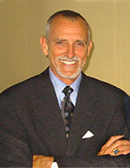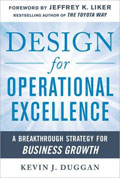Leapfrog competitors and save your bank money
Operational efficiency focuses staff on prime job
- |
- Written by Robert Hess
- |
- Comments: DISQUS_COMMENTS

Designing for Operational Excellence: A Breakthrough Strategy for Business Growth. By Kevin J. Duggan. McGraw-Hill. 304 pp.
Hess is CEO of TSG, Inc., a management information and performance improvement consulting firm. TSG, Inc. developed the TrakPointe Efficiency and Risk Management System (TERMS) for community banks.
* * *
I've been a fan--and a student--of processes every since my first assignment in Fort Knox, Ky., as a brand-new Army second lieutenant.
From my very first days as platoon leader, everything we did had a specific objective, and we always had limited resources--time, men, ammunition, and fuel--available.
Everything was a process, and every process had a checklist: planning for a mission, loading a vehicle, calling in fire support, starting up a helicopter. There were no exceptions.
 |
After 20 years of this, as you can imagine, everything for me is a process that can be distilled into a series of key steps that, in turn, can be measured and improved.
Operational excellence: Who doesn't want that?
Performance improvement is what I do for a living, so this book title caught my attention. I found it through an email from Amazon, which tracks the books I buy and notifies me when related books are released.
It was the title, however, that caught my attention: Designing for Operational Excellence: A Breakthrough Strategy for Business Growth.
Want more banking news and analysis?
Get banking news, insights and solutions delivered to your inbox each week.
The first element of the title, "designing," implies starting with the end in mind--the "mission" in military terminology--and then creating a product or process to meet a specific objective or customer need.
The keyword--"breakthrough"--in the title's second element, "A Breakthrough Strategy for Business Growth," closed the deal and I bought the book.
Process improvement isn't exactly the most exciting topic--in fact, it can be like reading the contract terms on your credit card agreement. But once I began reading this book I almost couldn't stop.
How to strive for operational excellence
Why couldn't I stop? Because Duggan's strategy changes process improvement from a long-term series of projects toward some vaguely defined future state into something community banks can plan for and accomplish in pretty short order, using just a few of the continuous improvement tools developed over the past 30 years.
Operational excellence is something that all organizations strive for, but most operational excellence plans tend to revolve around vision statements that aren't actionable.
Duggan defines a very simple, logical path companies can follow to jump to an operational excellence destination that is real and teachable--something that will bring tangible business growth to organizations that follow his roadmap.
Community banks can use Duggan's model to defend their turf against big bank encroachment; to gain a differentiation advantage against their competitors; and to improve their efficiency ratios, all at the same time.
Business success through continuous improvement
The Army doesn't have a lock on knowing that processes are important, and getting the right products to customers on time and "on quality" is fundamental to successful business.
The focus on process and quality improvement began in earnest with the Total Quality Management philosophy of Edward Deming, whose teachings showed that organizations can increase quality and simultaneously reduce costs by focusing on reducing waste, rework, and staff attrition, resulting in increased customer loyalty and profitability.
Then, in the 1980s and 1990s, we saw the arrival of lean manufacturing and the Toyota Production System, along with a complete suite of management philosophies and analysis tools for measuring, evaluating, and improving processes. The principal focus of all this effort was (and is) the identification and elimination of waste and quality improvement.
The continuous improvement goal is an ongoing program that produces incremental improvement of processes, products, services, and, ideally, customer loyalty and profits.
The key concept here is "continual improvement," meaning that there is never an end state; there's always something more a business can do to improve.
Search begins with a definition
"Operational excellence" can be defined in multiple ways, but they all define some general future state where companies have optimized their internal processes in order to be able to reward customers with products that have a mix of price, quality, and service that no other company in their industry can provide.
What organization doesn't want to reach operational excellence? But I'm an Army guy. I need a clear object and a plan to get there. Duggan provides the roadmap we need.
First, here is Duggan's definition of "operational excellence":
"A business that has implemented a self-healing value stream (process) that delivers products and services on time and on quality with virtually no management intervention, freeing operations management to fully participate in growing the business. The destination is perpetual business growth.
"It's about understanding that operations is a strategic part of the business that can have an impact on market share, break into new markets, adapt to changing markets, keep the business ahead of the competition, and return sustained shareholder value."
My key takeaways from this includes: "self-healing," "virtually no management intervention," and "perpetual business growth."
These are pretty exciting words, but how does it get done?
8 steps to excellence
Critical elements in Kevin Duggan's blueprint:
1. Understand the fundamental points. You need to know precisely what your organization needs to be able to do.
This is not a general vision statement of some future state, but a clear definition of the customers you will serve, the products and services you will deliver, and how you will create them.
2. Acquaint staff with their real jobs. Each employee must be taught where the organization is going and what their specific role is in helping the organization reach this objective.
3. Build a pipeline without bottlenecks. There must be an efficient system for delivering value--the product or service--to the customer. [This is the value stream flow we hear about in lean manufacturing parlance.]
4. Teach everyone to be a plumber. Be sure that each and every employee can see the flow of value to the customer and fix the flow before it breaks down.
5. Deliver solutions, not products or services. Creating a self-healing flow frees up value operational management time that is used to move the company from being a product or service provider to being an innovation solutions provider to its clients.
6. Point managers to tomorrow, not today. The goal is a product/service flow that works without continual management intervention. The manager's role now is to plan the future state, teach the employees the "why?" and "how," and then intervene as little as possible.
7. Go for leaps, not steps. Organizations can plan for this future state and create a roadmap to reach it in a short period of time--a jump--and avoid spending years on the never-ending staircase of continuous incremental improvement.
8. Revel in the advantage of small. Small organizations have an advantage over large organizations in making a jump directly to Operational Efficiency.
Why Duggan's model matters
Organizations that implement the program will have flows of products and services that customers want--the value stream--and they will be able to produce those products and services in the most efficient and effective manner possible.
The employees themselves will have ownership of the value stream and will repair if it begins to have problems.
The management time saved from daily management of the value stream is available for working directly with customers to develop new products and services to improve their businesses. Having this time available provides a significant market advantage.
Operational excellence distilled into Army terminology and process
I think of Duggan's process as three basic steps:
1. Design. Know what you want your organization to be able to do in terms of clients served and products and services delivered. Then, develop the blueprint in terms of processes and assets--people, equipment, facilities, and capital.
2. Build. Use the appropriate Lean Six Sigma/Continuous Improvement tools to implement the design, remembering Duggan's fundamental tenet that success depends on teaching the employees--the "Doers"--why and how, and letting them own the process. The manager's role is teaching.
3. Monitor. Duggan continually stresses the importance of visual indicators of abnormal conditions. These visual indicators cue the workers when the value stream needs attention. Management needs to monitor both the health of the value stream and their own set of indicators of how well they are spending their time interacting with current and future clients to grow the business.
What does this mean for community banks?
Duggan's model can be implemented in community banks. Doing so will show everyone in the bank why and how what they do matters; get everyone focused on doing the right things; clearly link resource allocations and expenditures to a defined operational business strategy; ease staff workload; and improve the bank's efficiency ratio.
The end result?
Competitive advantage, and who isn't trying to create that?
I recommend you read the book, and decide if Duggan's model makes sense for your organization. If it does, have your senior team also read the book.
Then allocate four hours of your next management offsite to creating a rough blueprint of your bank's state of operational excellence state. Better yet--have your senior management team read the book now and schedule a four-hour session as soon as you can.
Then pick your first easy process and begin designing to outperform your competition.














